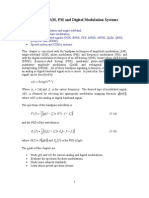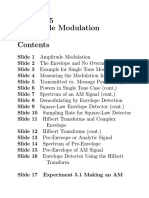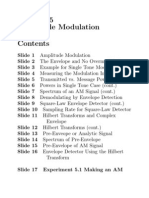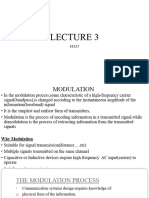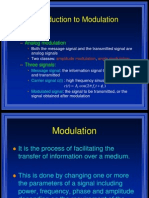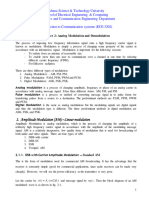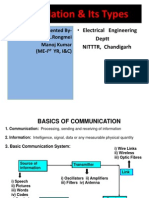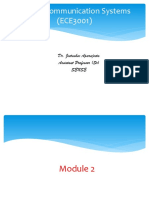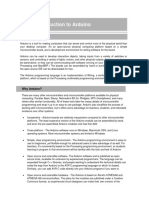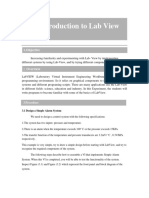Amplitude Modulation Systems
Modulation: is the process by which some characteristic of a carrier c(t ) is varied in
accordance with a message signal m(t ) .
Amplitude modulation is defined as the process in which the amplitude of the carrier c(t ) is
varied linearly with m(t ) . Four types of amplitude modulation will be considered in this
chapter. These are normal amplitude modulation, double sideband suppressed carrier
modulation, single sideband modulation, and vestigial sideband modulation.
A common form of the carrier, in the case of continuous wave modulation, is a sinusoidal
signal of the form
c(t ) AC cos(2f C t )
The baseband (message) signal m(t ) is referred to as the modulating signal and the result of
the modulation process is referred to as the modulated signal s(t ) . The following block
diagram illustrates the modulation process.
We should point out that modulation is performed at the transmitter and demodulation, which
is the process of extracting m(t ) from s(t ) , is performed at the receiver.
Normal Amplitude Modulation
A normal AM signal is defined as:
s (t ) AC 1 k a m (t ) cos2 f C t
where, ka is the sensitivity of the AM modulator (units in 1/volt). s(t ) can be also be
written in the form:
s(t ) A(t ) cos 2fCt
where, A(t ) AC AC k a m(t ) . In this representation, we observe that A(t ) is related to
m(t ) in a linear relationship of the form y a bx .
The envelope of s(t ) is defined as
A(t ) AC 1 k a m(t )
Notice that the envelope of s(t ) has the same shape as m(t ) provided that:
1
� 1. 1 k a m(t ) 0 or, equivalently, k a m(t ) 1 . Over-modulation occurs when
k a m(t ) 1, resulting in envelope distortion.
2. f C w , where w is bandwidth of m(t ) . f C has to be at least 10 w . This ensures
the formation of an envelope, whose shape resembles the message signal.
Matlab Demonstration
The figure below shows the normal AM signal s(t ) (1 0.5 cos 2 t )cos 2 (10)t
a. Make similar plots for the cases ( = 0.5, 1, and 1.5)
b.Show the effect of f C on the envelope. (Take f C = 4 Hz, and f C = 25Hz)
Spectrum of the Normal AM Signal
Let the Fourier transform of m(t ) be as shown (The B.W of m(t ) = w Hz).
s(t ) AC 1 ka m(t ) cos 2fCt (dc + message)*carrier
s(t ) AC cos 2fCt AC ka m(t ) cos 2f C t (carrier + message*carrier)
Taking the Fourier transform, we get
2
� AC A Ak Ak
S( f ) ( f fC ) C ( f fC ) C a M ( f fC ) C a M ( f fC )
2 2 2 2
The spectrum of s(t ) is shown below
Remarks
a. The baseband spectrum M ( f ) , of the message has been shifted to the bandpass
region centered around the carrier frequency f C .
b. The spectrum S (f ) consists of two sidebands (upper sideband and lower sideband)
and a carrier.
c. The transmission bandwidth of s(t ) is:
B.W ( f C w) ( f C w) 2w
Which is twice the message bandwidth.
Power Efficiency
The power efficiency of a normal AM signal is defined as:
power in the sidebands
power in the sidebands power in the carrier
Now, we find the power efficiency of the AM signal for the single tone modulating signal
m(t ) Am cos(2 fmt ) . Let Amka , then s(t ) can be expressed as
s(t ) AC (1 cos 2f mt ) cos 2f C t
s (t ) AC cos 2f C t AC cos 2f C t cos 2f m t
AC A
s (t ) AC cos 2f C t cos 2 ( f C f m )t C cos 2 ( f C f m )t
2 2
Carrier
Upper Lower
Sideband Sideband
3
� 2
A
Power in carrier C
2
1 A 1 A
2 2
Power in sidebands C C
2 2 2 2
1 2 1 2 1 2
AC 2 AC 2 AC 2
8 8 4
Therefore,
1 2 2
AC
2
2 4 ; 1 0
1 2 2 2
2
AC
AC
2 4
The following figure shows the relationship between and
0.3
0.25
0.2
0.15
0.1
0.05
0
0 0.1 0.2 0.3 0.4 0.5 0.6 0.7 0.8 0.9 1
The maximum efficiency occurs when = 1, i.e. for a 100% modulation index. The
corresponding maximum efficiency is only = 1/3. As a result, 2/3 of the transmitted power
is wasted in the carrier.
Remark: Normal AM is not an efficient modulation scheme in terms of the utilization of the
transmitted power.
Exercise:
a. Show that for the general AM signal s(t ) AC 1 kam(t ) cos(2 fct ) , the power
1 2 2
AC ka m(t )2 ka 2m(t )2
efficiency is given by 2 , where
AC 2 1 2 2 2 1 ka 2m(t )2
AC ka m(t )
2 2
ka 2m(t )2 is the average power in ka m(t )
b. Apply the above formula for the single tone modulated signal
s(t ) AC (1 cos 2f mt ) cos 2f C t
4
�AM Modulation Index
Consider the AM signal
s(t ) AC 1 ka m(t ) cos 2fCt A(t ) cos 2f C t
The envelope of s(t ) is defined as:
A(t ) AC 1 k a m(t )
The following block diagram illustrate the envelope detection process for a sinusoidal
message signal.
To avoid distortion, the following condition must hold
1 k a m(t ) 0 or k a m(t ) 1
The modulation index of an AM signal is defined as:
A(t ) max A(t ) min
Modulation Index (M .I )
A(t ) max A(t ) min
Example: (single tone modulation)
Let m(t ) Am cos 2f mt
then, s(t ) AC (1 k a Am cos 2f m t ) cos 2f C t
AC (1 cos 2f m t ) cos 2f C t where, k a Am
To avoid distortion k a Am 1
The envelope A(t ) AC 1 cos 2f mt is plotted below
A(t ) AC (1 ), A(t ) AC (1 )
max min
AC (1 ) AC (1 ) 2AC
M .I
AC (1 ) AC (1 ) 2AC
5
�Therefore, the modulation index is .
Over-modulation
When the modulation index 1 , an ideal envelope detector cannot be used to extract m(t )
and distortion takes place.
Example: Let s(t ) AC (1 cos 2f mt ) cos 2f C t be applied to an ideal envelope
detector, sketch the demodulated signal for 0.25, 1.0, and 1.25 .
As was mentioned before, the output of the envelope detector is y(t ) AC 1 cos 2f m t
Case1 : ( = 0.25)
y(t ) AC 1 0.25 cos 2f mt
y (t )
Here, m(t ) can be extracted without distortion.
Case2: ( = 1.0)
y(t ) AC 1 cos 2f mt
Here again, m(t ) can be extracted without distortion.
Case3: ( = 1.25)
6
� y(t ) AC 1 1.25 cos 2f mt
Here, m(t ) cannot be recovered without distortion.
Generation of Normal AM:
Square Law Modulator (will not be covered for ENCS students)
Consider the following circuit
For small variations of V1 (t ) around a suitable operating point, V2 (t ) can be expressed as:
V2 1V1 2V1 ; Where 1 and 2 are constants.
2
Let V1 (t ) m(t ) AC cos 2f C t
Substituting V1(t ) into the nonlinear characteristics and arranging terms, we get
2 2
V2 (t ) 1 AC 1 2 m(t ) cos 2f C t 1m(t ) 2 m(t ) 2 2 AC cos 2 (2f C t )
1
V2 (t ) (1) (2) (3) (4)
The first term is the desired AM signal obtained by passing V2 (t ) through a bandpass filter.
2
s (t ) 1 AC 1 2 m(t ) cos 2f C t
1
7
� Note: the numbers shown in above figure represent the number of term in V2 ( f ) .
(1) = The desired normal AM signal
(2) = M ( f )
(3) = M ( f ) * M ( f )
(4) = The cosine square term amounts to a term at 2fc and a DC term.
Limitations of this technique:
a. Variations of V1 (t ) should be small to justify the second order approximation
of the nonlinear characteristic.
b. The bandwidth of the filter should be such that f C w 2w f C 3w
When f C w , a bandpass filter with reasonable edge could be used.
When f C is of the order 3w , a filter with sharp edges should be used.
Generation of Normal AM:
The switching Modulator (will be covered)
Assume that the carrier c(t ) is large in amplitude so that the diode –shown in the figure
below- acts like an ideal switch.
When m(t ) is small compared to c(t ) ,
8
� m (t ) AC cos C t ; c (t ) 0
V 2 (t )
0 ; c (t ) 0
Here, the diode opens and closes at a rate equals to the carrier frequency f C . This switching
mechanism can be modeled as:
V2 (t ) AC cosC t m(t )g P (t )
where g P (t ) is the periodic square function, expanded in a Fourier series as
1 2 1 1
g P (t ) cosC t cos 3C t cos 5C t ...
2 3 5
1 2 2
V2 (t ) AC cos C t m(t ) cos C t AC cos C t m(t ) cos 3C t
2 3
m(t ) AC cos C t ...
m(t ) AC 2 A A 2
V2 (t ) cos C t m(t ) cos C t C C cos 2 C t m(t ) cos 3 C t
2 2 3
2
AC cos 2C t ...
3
2 fC
A bandpass filter with a bandwidth 2 w , centered at f C , passes the second term (a carrier)
and the third term (a carrier multiplied by the message). The filtered signal is
9
� AC 2
s(t ) cos C t m(t ) cos C t
2
A 4
s(t ) C 1 m(t ) cos C t ; Desired AM signal.
2 AC
4
Modulation Index M .I m(t ) max
AC
Demodulation of AM signal: (The Ideal Envelope Detector)
The ideal envelope detector responds to the envelope of the signal, but is insensitive to phase
variation. If
s(t ) AC 1 ka m(t ) cos 2fCt
then, the output of the ideal envelope detector is
y(t ) AC 1 k a m(t )
A simple practical envelope detector
It consists of a diode followed by an RC circuit that forms a low pass filter.
During the positive half cycle of the input, the diode is forward biased and C charges rapidly
to the peak value of the input. When s(t ) falls below the maximum value, the diode
becomes reverse biased and C discharges slowly through RL . To follow the envelope of
s(t ) , the circuit time constant should be chosen such that :
1 1
RL C
fC w
Where w is the message B.W and f C is the carrier frequency.
10
�When a capacitor C is added to a half wave rectifier circuit, the output follows the envelope
of s(t ) . The circuit output (with C connected) follows a curve that connects the tips of the
positive half cycles, which is the envelope of the AM signal.
11
�Example: (Demodulation of AM signal)
Let s(t ) 1 k a m(t ) cos C t be applied to the scheme shown below, find y (t ) .
2
v(t ) s(t )2 1 kam(t ) cos2 C t
1 2 1 2
1 kam(t ) 1 kam(t ) cos 2 C t
2 2
The filter suppresses the second term and passes only the first term. Hence,
1
(t ) 1 k a m(t )2
2
1
y (t ) (t ) 1 k a m(t )
2
1
y (t ) k a m(t )
2
Note that the dc term is blocked by capacitor.
Concluding remarks about AM:
i. Modulation is accomplished using a nonlinear device.
ii. Demodulation is accomplished using a simple envelope detector.
iii. AM is wasteful of power; most power resides in the carrier (not in the
sidebands).
iv. The transmission B.W = twice message B.W
12





